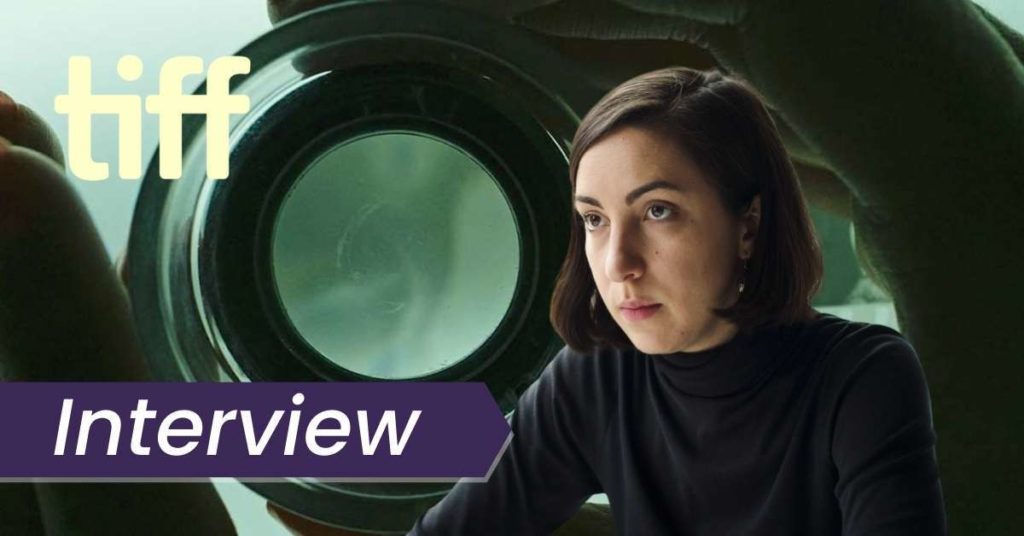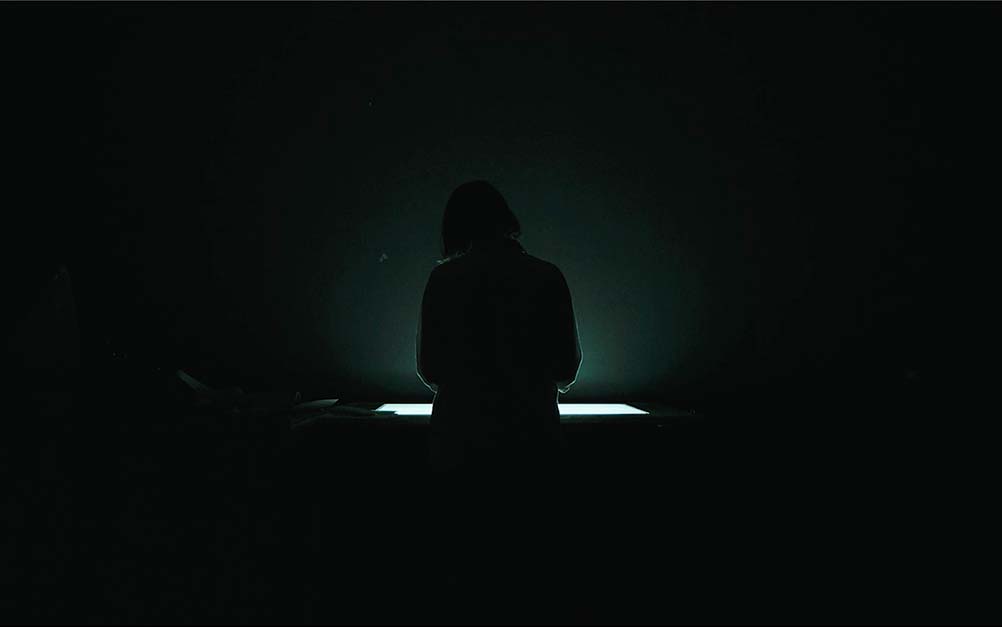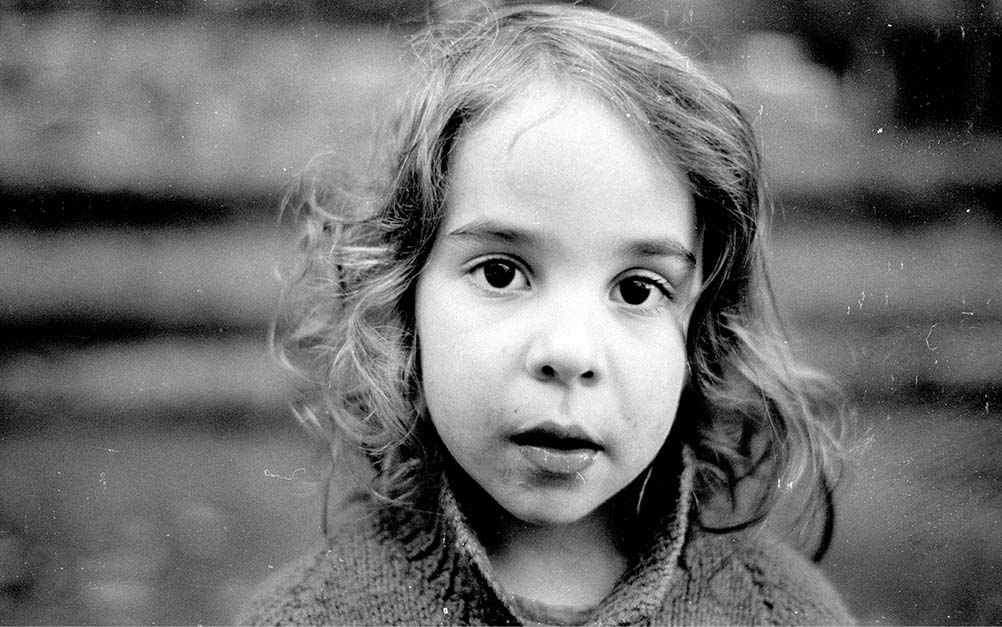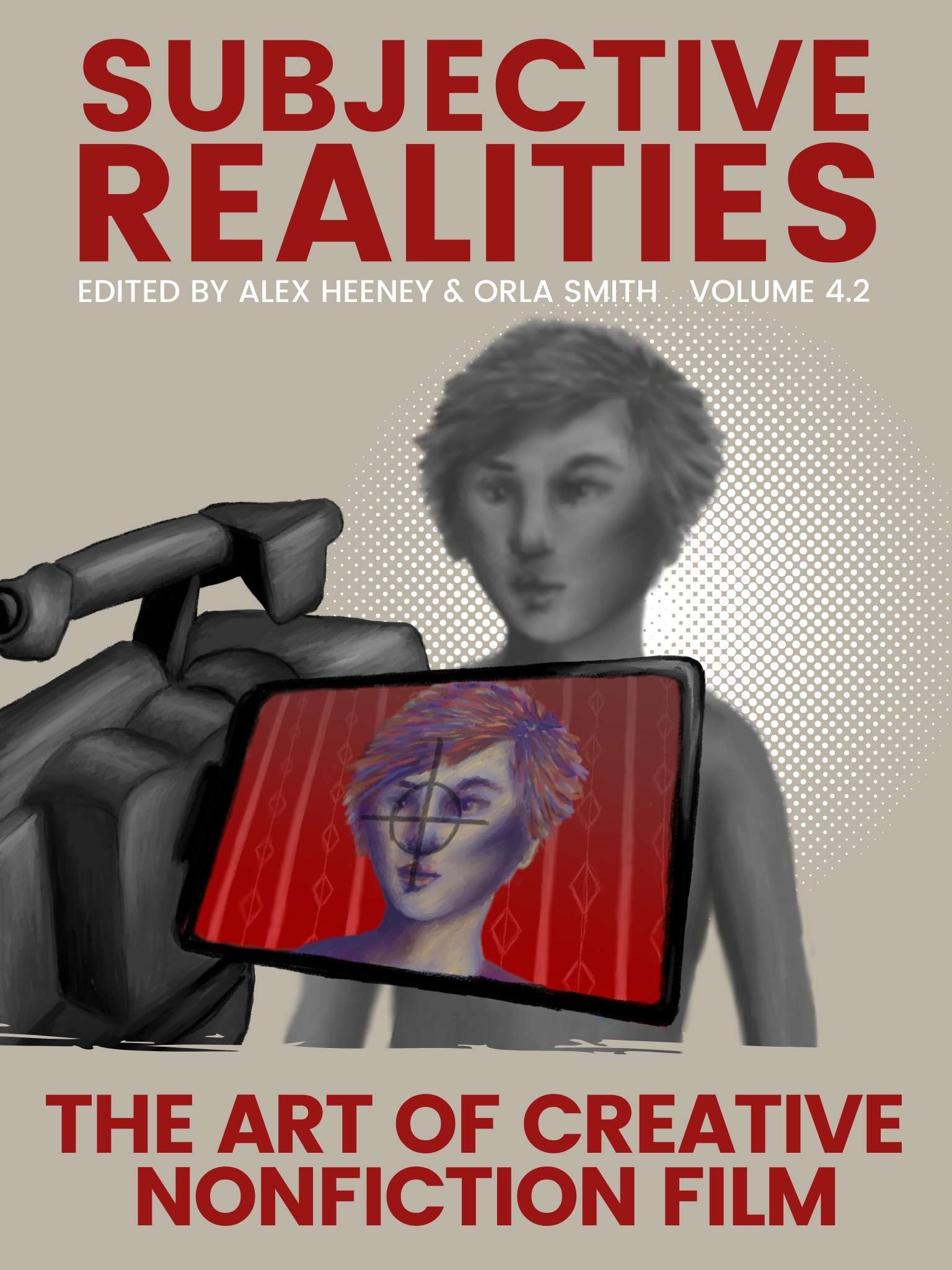Sophy Romvari’s deeply personal documentary short, Still Processing, is a triumph of personal cinema. Romvari discusses how to make a film that’s both personal and universal and how to get your name out there as a short filmmaker. Keep up to date with our TIFF ’20 coverage.

Discover one film you didn’t know you needed:
Not in the zeitgeist. Not pushed by streamers.
But still easy to find — and worth sitting with.
And a guide to help you do just that.
In Sophy Romvari’s personal documentary, Still Processing, she holds memories in her hands. After a long negotiation with her parents over her desire to make a film reflecting on her two older brothers’ deaths, her father presents her with a box of photos, videos, and film negatives. We watch as, for the first time, she takes them out. In black and white photographs taken by her father, we see children at rest and play. In one photo, a young Sophy is captured in closeup, looking directly into the camera. It’s a confrontational image, and given the film’s subject, it’s hard not to read melancholy in her expression. The photos capture an almost foreboding doom. They capture fleeting expressions that are transformed by events that follow.
On Still Processing
The film’s title gestures at the double meaning of living with grief and also the process of discovering these photos and literally processing the negatives. Much of the film unfolds at York University, where Romvari was studying her Master’s degree at the time of shooting (Still Processing is her thesis film). The school’s brutalist institutional atmosphere contrasts with the film’s emotional intensity. Virtually wordless, Romvari’s film uses reflective subtitles at the bottom of the screen, adding context and insight.
Still Processing treads a careful line between intimacy and vulnerability. The filmmaking invites viewers to witness and engage rather than merely invade a private moment. In the difficult realm of dealing with profound loss, Romvari touches on rarely expressed ideas and emotions. Though very much her film, the use of Romvari’s father’s photos and her brother Ben’s music express, through collaboration, the fortitude of familial bonds.
How Still Processing fits into Romvari’s body of work
Still early in her career, Still Processing feels like a natural progression for Romvari who has made a series of films that interweave the personal and the universal. In Nine Behind (2016), the first film she made after completing her undergrad at the University of Vancouver, a young woman calls her grandfather in Budapest to learn about the Hungarian film industry. Shot in black and white, and autobiographical without being autobiography, the film is as much about reflecting on the alienation and loneliness of the main character’s disconnect from language and history, as it is about the subject of the phone calls themselves. It is a film about absence rather than presence, an empty apartment and an unfulfilled desire to connect with family members who are literally and spiritually so far away.
Sophy Romvari’s Nine Behind and Pumpkin Movie
Nine Behind has a formal rigour that Romvari somewhat abandons in some of her later work. In movies that follow, such as Pumpkin Movie, there is a suppleness in the image that betrays how quickly it is made but lends a sense of intimacy few filmmakers can ever achieve. Pumpkin Movie (2017), about two old friends continuing a pumpkin carving tradition over Skype, the script was partially crowd-sourced as Romvari asked people to submit negative encounters with men. The integration of laptops and online video chatting further highlights how Romvari’s cinema often reflects how technology shapes our relationships with others, for better and worse, and how it has the power to capture and transform memory and ideas.
Norman, Norman and Dog Years
With Norman, Norman (2018), Romvari shifts focus to mortality. Norman, Norman, a portrait of Romvari’s elderly dog, inquires into the finite nature of existence and the future technological promises that challenge our very conception of life and death. Beyond just a cinematic portrait, the film inquires into Barbara Streisand’s decision to clone her dogs and what it might mean for the future. What happens when death no longer signals non-existence? How will that change our relationships with those around us?
This film’s beauty lies in its simplicity and its deep affection for its subject. It matches up beautifully with Romvari’s In Dog Years (2019), an expanded portrait of elderly dogs and their owners. Both films, quite radical in their framing, adopt a non-human perspective, bringing us down to the eye-line of animals. They’re films that echo with love and wonderment, even if they’re inflected with the tragedy of impending loss.
Working in creative nonfiction
Much of Sophy Romvari’s cinema operates in the tenuous world of creative nonfiction. They’re films that eschew traditional narrative structure and engage with artificial elements to come to a greater sense of truth. Her style, still evolving, reveals a filmmaker unafraid to take risks and make films off the cuff. They’re movies that fully embrace the possibilities of short-form storytelling.
Sophy Romvari’s commitment to short films has recently extended to another project, called Exquisite Shorts. Inspired by conversations surrounding festival programming for short films, Romvari launched a crowdfunding campaign to create an alternative short film distribution model for and by filmmakers that focuses on the sustainability of the form, including fair compensation for creators.
Speaking with Sophy Romvari over Zoom, we discussed the making of Still Processing, her ideas surrounding personal filmmaking, and building online communities.
The evolution of Still Processing
Seventh Row (7R): Still Processing was your Master’s project at York University in Toronto. Could you talk about the evolution of the project?
Sophy Romvari: I applied to York at the end of 2016. I already had the film concept, pretty much as it appears now. There would be multiple scenes that were just different phases of processing the photographs and looking at the videos. I never wrote a full script. I followed that basic outline from when I applied to York.
To that end, the concept didn’t change very much. It was the emotions that came out that changed or evolved [the project]. Since applying to do my Master’s, between then and now, I’ve worked on a lot of films dealing with personal experiences and the idea of processing experiences through filmmaking. It’s a little bit like they were the pre-production for this film.
I wanted to go to York because I heard great things about the faculty. I was going to need time, space and support to make it [Still Processing] and objective guidance, and I got that from my supervising team. When I got into the program, my parents were still pretty guarded about making a film about the subject. But they were excited for me. Then, I started to say to them I wanted to make this film and what it was about. That started a long negotiation period with them, and it was a year before I got their permission. In the program, I was just doing coursework and research. Anything I could to prepare to make the film, knowing it was possible that I would not get to make it.
Getting permission
There were a lot of really emotional, intense conversations between my parents and me. I think part of it was that they couldn’t imagine a film that wasn’t a documentary about what happened. They couldn’t imagine that it would be something that wouldn’t touch on the specifics. I think that was scary for them; they didn’t want me to make a big exposé documentary about our family. I tried to describe it and give them examples. But it was still really hard for them to see it and to understand.
At a certain point, I think it just struck my parents how much it meant for me to make the film. And they gave me their blessings. My dad even wrote a letter which is included in the film. It meant so much to me to have that sense of artistic collaboration with him, but also emotional collaboration.
Whose story is Still Processing?
There’s a complicated negotiation with this film: whose story is it? Because it’s mine, my brother Ben’s, my parents’ and then, of course, my brothers’, David and Jonathan. You can’t pull apart those experiences. Trying to find the right way to tell the story from my experience and being gentle and considerate of everyone else’s experience took a long time. I wanted to make sure the film was never just for me, but for my family. I finally shot the film in 2018.
After I got permission from my parents, they mailed me a box of all kinds of things. There were little knick-knacks that were all from my dad’s time and experience in film school. But I didn’t open that box; I didn’t look at it. I got the box about six months before I made the film.
Preparing for the shoot
I knew I was going to shoot the film with my DP, Devan Scott. He has shot almost all my films. Then, it was about getting him to fly out from Vancouver. We set aside ten days to shoot the film. Most of it was shot at York University on campus. We had already done a pre-scout of the location on a different trip when he came out to shoot In Dog Years.
We already knew every room we wanted to use and every angle. Now, it was just about creating the right atmosphere and space to let the film happen. We shot for 10 days, not because we needed to shoot for 10 days but because we wanted to do one scene a day, which is not normal for a short film. We wanted to set aside enough time to not emotionally overwhelm me. Also, because it was just Devan and I shooting, we had a lot of work. We were both setting up cameras and setting up the sound.
Opening the box
For the box opening scene at York, in the morning and a lot of the day, I felt nervous because I knew I was going to be seeing these photographs for the first time. We set up two or three cameras, almost like a television shooting setup, similar to what we did for Pumpkin Movie. It was a way to capture all angles so that you don’t have to go back and reshoot anything, so it can all be live.
Once we started rolling, I walked into the scene with the box. Devan put headphones in, and he just checked out because he wanted to give me full emotional space. I went through the box in real time. We filmed that shot for about 45 minutes. I just looked at everything and let whatever came up come up. We shot a few inserts after that, but we didn’t redo any shots or punch in for a closeup or anything; it was all done in that one [setup]. We did a similar setup for most of the film; we just wanted to capture the actual emotion.
Preparing to watch the footage
I sat on the footage for about a year because it was too overwhelming to look at. Finally, when I started to look at it, I wasn’t sure how I would turn it into a film that other people could watch. I never imagined it would take as long as it did, that’s for sure. But at the same time, I think it couldn’t have been made any faster. Now that it’s playing for people, I’ve never felt such unreal anticipation. Most of my shorts I made so quickly. This one is a huge, completely different experience.

Sophy Romvari on “Personal” cinema
7R: Could you explain your connection with making “Personal” Cinema?
Sophy Romvari: Making personal films came naturally because I just had a lot to process. I did a four-year undergrad at the University of Vancouver, and I was getting the opportunity to direct short films. They were all scripted short films that other students had written. The program emphasized the separation of roles. They don’t want people to make their own films, and they don’t want people to be auteurs, because they’re trying to train people into the film industry in Vancouver. It’s a very streamlined system.
I directed four short films, which were all about middle-aged white men having a midlife crisis. They were great experiences for me to try out different stylistic approaches. I definitely ripped off Lynch or Wes Anderson or all these typical film school inspirations. I had the opportunity to learn a lot of technical skills as I gained confidence as a director. When I finished the degree, I felt empty about the films I was making.
On family and Nine Behind
My family is Hungarian, and I spoke Hungarian for the first few years of my life, but I don’t speak it anymore. My parents were from there, and they never went back after they immigrated for very complicated reasons. I’ve always had this real longing to reconnect with that part of my identity. Nine Behind was my first attempt to start bridging that gap. I cast an actress to play a surrogate version of myself. Getting to make that film was a huge shift because I was like, “Wow, I care about this, and I want to share this with people.” I found a way to make a film that was at once personal and universal. That’s always been what I’m trying to get: something that is born out of really personal [experience] that’s also something that people can inject their own experience into.
From Nine Behind onward, I started to delve into those experiences, diving deeper into this hybrid documentary world. I went to True/False [documentary film festival] with Pumpkin Movie where so many films were doing this hybrid technique, and I was like, “That’s it. That’s what I like. That’s my mode.” I find that hybrid filmmaking and personal filmmaking allow you to be honest about the fact that you are making a film, and there are inherent artificialities to it. I find it to be a more honest depiction of reality.
The potential of personal filmmaking for emerging filmmakers
Personal filmmaking has a lot of potential, especially for emerging filmmakers or people who are trying to get into the film industry. I don’t like this idea that it has to be a stepping stone. Some people just want to make shorts. They’re so much more accessible, and they cost less money. Personal filmmaking is also a budgetary thing. You can use what you have around you. Depending on the way you want to execute work, it can be a lot cheaper to make self-reflection or something that you’ve experienced rather than a genre piece. A sci-fi or horror film, of course, can also be deeply personal. But I think that’s why there is a lot of Canadian hybrid personal filmmaking.
A viewing list for Still Processing
7R: From what I understand, you also built a “viewing” list for the project. I imagine part of it was a requirement for your degree, but can you talk about the films that informed Still Processing?
Sophy Romvari: With my past films, there was never really a reference point of what inspired that work. For me, it’s more that I’m watching films and being like, “Oh, a film can do that!” or “A film doesn’t have to include a narrative structure in a traditional sense!” For Still Processing, I built a self-directed study of 20-odd films that were dealing with personal filmmaking or documentary/hybrid and trauma, these kinds of light-hearted tags.
The more helpful thing about watching those films was seeing the things I didn’t want to do and didn’t want the film to be. I wanted to build the film without these obvious emotional beats. You can’t count on people caring about your personal life if you don’t give them a reason to care. [Watching personal films, you feel sometimes that filmmakers] want you to care about something that they care about, but they don’t necessarily give you a reason to. The way to get around that is to create a very distinct access point from the very beginning. For example, what are the stakes of this film? To keep someone’s interest in the film, I knew that I had to reveal early on the specific grief that I was dealing with, to have people understand what I was grappling with.
Inspiration for the subtitles
A big part of that came through in the subtitles. When I shot the film, I knew that I would include some pre-text [an explanatory intertitle before the film] or voiceover, but I wasn’t sure what. The subtitles allow me to say what I wasn’t able to say or show in the film. I didn’t want to do it in voiceover because I think that can be overbearing and would pull away from the experience as you’re watching it. The films of Su Friedrich used subtitles similarly. I didn’t want just to deliver information; I wanted there to be a poetic quality to what I was saying. I needed to find the right way to phrase things. It took a long time to find the right words.
There was also a film by this German filmmaker, Heinz Emigholz, called Streetscapes [Dialogue], which was recommended to me by Lydia [Ogwang], where he’s talking to a psychiatrist the entire time. The way he frames the shots with canted angles of this crazy architecture was an inspiration for framing the shots around York University and wanting to show that space the way that we did.
I also watched a lot of Akerman, like every female filmmaker doing personal work does.
Filming at York University
7R: Can you discuss using York University as a backdrop? Was that always a part of your plan for the film?
Sophy Romvari: I wanted to create a very distinct contrast and juxtaposition between the footage that I was filming with myself and the photographs and videos that my dad had made. It was important to me to have the warmth of the photographs and videos be in complete contrast with the coldness and almost futuristic aesthetic of York. The blues and the grays and the winter of the time that we shot helped emphasize that visual juxtaposition.
We took a long time walking around [the school], finding different windows and angles with interesting shadows. Most of those spaces I had never been in during my actual classes. The main room that we found for the box opening was a painting studio. It just had these beautiful windows which created a great space for doing that work. We didn’t have to use any lights for shooting because we had this beautiful natural light coming in from this wall of windows.
Sophy Romvari on representing a period of her life spent at York University
I wanted this film to represent this period of my life. I was doing my Master’s at York. Without being too metatextual, I wanted to make a film about me making a film. I wanted to make the film about the process of doing my thesis and uncovering these emotions in the space in which I did it. Of course, there’s the added element that I had access to all those spaces so I didn’t have to pay for any of them. That kept the budget low. Almost the entire budget was just flying Devan to Toronto and then paying him to shoot the film.
Also, shooting in the winter lent itself to that sort of cold contrast. I wanted this sense of being imported into the space of the photographs and videos, and then being pulled back into the cold reality of what I was facing. That contrast, visually, was helped out by the brutalism of York and this sort of institutional space.
Working with DP Devan Scott
7R: You’ve already spoken about your DP, Devan, but could you talk about your working relationship? Considering the film’s scale, and your vulnerability, I imagine a lot of trust was involved.
Sophy Romvari: Devan and I met after I graduated from my undergrad. We did not go to film school together. He went to UBC. I was introduced to him by a mutual friend when I had just written the script for Nine Behind. I did not have a great time in my undergrad in terms of the school’s dynamics and creativity. It was a very competitive space, and I found it difficult to forge healthy working relationships. I didn’t leave the program with a solid group of filmmakers [to collaborate with] because everyone had very different ideas about the kinds of films they wanted to make.
I met Devan, just by happenstance, during a film festival, and I just started telling him I wrote the Nine Behind script. He was like, “Do you want me to shoot it?” I was like, who is this completely out-of-the-blue generous person that I’ve never met before who just offered to shoot my film? That’s very Devan-like; he’s super generous with his time and very eager and curious to learn about other people’s processes. He’s the kind of DP that works with different people, and the films always look and feel different.
He shot Nine Behind, and suddenly, rather than creating films being a stressful experience, it was a joy. The discovery and curiosity Devan brings lent a lot to the films. I knew that it would be a very intense and intimate experience with Still Processing, and I would never have considered shooting with anyone else.
How Devan Scott works
Working with Devan is like a one-man show. He shoots the film; he knows everything about lenses; and he knows everything about technology. Then, as we’re shooting, he’ll import the footage, and he’ll do a pre-colour grade on it. So I already know how it’s going to look.
Devan shoots for his colour grading. He’s sometimes shooting a little bit overexposed or underexposed because he knows exactly what the colour grading will adapt to. I know so much more about how the film will look at the end working with Devan, so I don’t have to think about those things while I’m making the film. We do a lot of pre-shooting also, so I don’t have to wait to see what the film will look like. We’ll do test shots of everything.
On photos in Still Processing
7R: The title and the subject refers to the tactile nature of photography. Can you explain the importance of the photos?
Sophy Romvari: I grew up with a dad who was constantly photographing and filming us. It was very much part of normal day-to-day life for us, which lends itself to my ability to be vulnerable and at ease on camera. I have all of these memories of being photographed and filmed, but I never saw any of the photos because of the circumstances with my family. I’ve seen, like, one or two that were printed around the house, and my dad would send me a photograph on my birthday.
I knew there were thousands of photographs I had never seen. I had built up the anticipation of seeing them, and then when the two deaths occurred, it just made it that much more loaded. It built itself up: wanting to see these things, wanting to hold these things. Just knowing they existed was such a gift. The idea of seeing them was terrifying but exciting at the same time. I’m so lucky that I have those photos. Not everybody has documentation of their early years and not in the way that my dad did them. He’s an exceptionally talented photographer in his own right; he was studying to be a cinematographer. There’s something that feels to me like a kind of retroactive collaboration between his work and mine now.
Some photographs had never even been developed. At York, I was lucky enough to learn the process of developing photographs. I included the teacher who taught me the process, Marcos [Arriaga], in the film.
“I wanted to show the process of processing”
For a lack of better words, I wanted to show the process of processing. I wanted to see the photographs for the first time, and then develop the photographs for the first time, and then see this video footage for the first time, which I did with my brother Ben. It made sense to document the fact that it was happening for the first time.
When I looked at the photographs, I found those devastating. Partly because of my dad’s style. He has this very Eastern European [photography] aesthetic. They’re not like regular family album photos. They’re very intense photos of children. I have compared his work a little bit to Sally Mann. She photographs her children, and they’re all serious and intense. I read a lot about the theory of photography by Susan Sontag and Camera Lucida.
Part of what I found interesting about the experience was the difference between seeing a photograph and what a photograph means. Photos feel so much more in line with the past, and honestly, with death. They are a record of a moment, a snapshot, and a very different experience than seeing videos. So when I saw the photographs, they made me cry. The videos made me laugh. The videos were somehow less devastating because they felt that they were happening in the moment. They felt real, something that still exists.

The presence of Sophy’s brother Ben in the film
7R: Can you talk a little bit about your brother Ben’s presence in the film?
Sophy Romvari: We grew up with four siblings, and now we’re the only two left, so we have a very close, sacred relationship. We’re the two youngest, also. When you have such a small family, you always have to be aware of how grateful you are for those people in your life, especially when you experienced such intense loss. Ben and I are a big part of each other’s lives.
No one has an insight into my experience the way that Ben does. Being a sibling who loses a sibling, never mind two, is a completely different experience than being a parent that loses a child. They’re not comparable. That’s a big part of why my relationship with Ben is so important, because we have that shared experience. I needed him to be a part of the film because it was important for him to see those things and process those things alongside me.
We watched those videos and realized we both have this really terrible recall and memory ability. I’ve read a lot about how, when you experience complicated grief, it does affect your memory, and it does affect your ability to recall specifics. The whole time we were watching it, we’re like, what year was that? How old are we? That’s why it’s really nice and lucky that we have these documents to fill in those gaps.
How Still Processing was a way of healing
7R: On Twitter, you spoke about using this film as a way of healing. What do you mean by that?
Sophy Romvari: I have this desire to teach what we’ve been talking about, personal filmmaking as a means of processing experiences. I have worked a little bit in that world with my thesis supervisor, Brenda Longfellow. She works with incarcerated women and women who’ve experienced sexual trauma. During my masters, I worked with her leading a workshop where all the women had experienced some kind of sexual trauma and were making films or visual art pieces — not about their experiences necessarily, but just whatever they wanted to in terms of processing their experiences.
I spent a lot of time watching films looking for experiences where people lose siblings in the last ten years. I never really saw a film that spoke to me; I realised it was because I needed to make that film. People look to films to feel less alone about their experiences. Part of my hope in Still Processing is that maybe I will come across people who have those experiences or similar experiences. A huge part of the impact of filmmaking or cinema is connecting people through experiences and empathy.
The Exquisite Shorts project
7R: Shifting focus a little bit: you recently wrapped up a crowdfunding project called Exquisite Shorts. It is an online shorts program that re-imagines the role of the gatekeeper in film, while still allowing filmmakers to engage critically with each other’s work. You also aim to compensate filmmakers. Can you explain why you launched this campaign?
Sophy Romvari: There is this sort of unfortunate stigma around short filmmaking as a stepping stone toward features or proof-of-concept filmmaking, which are all fine. But there should be an emphasis on the legitimacy of short films.
Many people don’t have the access or time or ability to make a feature but have a few bucks and a couple of friends to get together and make a short film. If you want to see more diverse stories and want to see more diverse creators, support those filmmakers and support them financially because they’re not going to make these films or tell you stories if they don’t have the means to. Short films can give people that entry point.
Feeling encouraged to work within your means
I think people should feel encouraged to work within their means, but for something to be within your means, you have to provide some kind of means. In the industry, they don’t prioritize that experience at all. Short films are functioning right now on the festival circuit as, “You should be so lucky that your film is playing at this festival.” On some level, that’s true because there are so many films submitted, but there’s issues with that hierarchical system. [With this project, I’m] answering some of those concerns about the film industry and the film festival landscape.
Supporting short filmmakers
Now, I have the money to run it and pay people, but I also know that there’s interest and enthusiasm around the idea. It’s partially about normalizing paying short filmmakers. If you want to see more work from filmmakers you admire, you have to do more than just program their work. Paying screening fees, for example, creates a different atmosphere around the experience. If you’re not being paid, it sends a message about the work’s value.
I tweeted out a letter [from experimental filmmaker] Hollis Frampton a few days ago. He was being invited by MoMA to screen his work for love and exposure. And he outlines distinctly why he should be paid for his work. He cracks down on the argument of why filmmakers shouldn’t be screening their work for free. Imagine going to the dentist and saying, “I’ll tweet about the work you did on my teeth.” You can’t pay rent in Toronto with exposure bucks.
I’m excited to start the program and to make mistakes and learn from them. I’m running it currently just by myself, and I’m going to have the ability to shift and change things as it’s going.
Social media, filmmaking, and promotion
7R: You are very active on social media. Can you explain how you use platforms like Twitter and Letterboxd as it relates to filmmaking and promotion?
Sophy Romvari: As a filmmaker, it’s something that I always recommend to filmmakers who ask me how I get my work noticed. It was not a marketing plan I had. I just slowly became ingrained in this ‘Film Twitter’ subculture. I hit on this cross-section of critics, programmers, cinephiles, and filmmakers by being a part of it. It had a serious impact on my films being programmed. Honestly, if people see your work being interacted with online, a programmer, for example, might take an interest.
Especially when you’re dealing with things like blind submission, they don’t have much to go on, especially if you’re just an emerging filmmaker. For example, Pumpkin Movie, which was pretty early in my very short career, was programmed because the programmer, Chris Boeckmann, saw it on Twitter. He just happened to come across it, and he programmed it. I never submitted the film to True/False, and I got this email that I was programmed at this festival that I had heard such incredible things about. It was a huge shift for my career because it legitimized my work in a way that probably couldn’t have happened if I just had submitted it.
Being programmed like that without actually even soliciting had a huge impact on my confidence as a filmmaker.
Understanding the film community
I ended up developing the Exquisite Shorts concept. Seeing all these different complaints or confusion about the film festival circuit and just watching how those power dynamics work and learning how programmers can be, God loves them. Still, sometimes not the most ethical processes come out of that system. All of that has informed not only my filmmaking but also my ideas around filmmaking.
Letterboxd is a godsend. I always tell people to make sure your film is on Letterboxd because it’s a free platform to have people comment and react to and give feedback to your work. Right now, for Still Processing, Letterboxd is a treasure trove for me; seeing these reactions and reviews from people that I don’t know at all, in some cases, they write these really gut-wrenching reviews of my work. It’s hugely confidence-instilling for me to see that people take the time to do that.
On Twitter and Letterboxd
Twitter and Letterboxd are both free tools, but engaging with them comes with a downfall. Like everyone, sometimes, I want to log off entirely. Just put my work out there and hope that it flourishes. But I’m not at that point in my career. I think it’s hard to get to that point. The engaging can take a toll. But I genuinely have met a lot of really great people on Twitter. It’s benefited my career and just getting to meet like actual cinephiles. I think for anyone who’s living in a city or an area where there’s not a huge, robust film culture, Twitter can also be a huge saving grace.
READ: Our wrap-up of the best Canadian shorts at TIFF ’20, which included Sophy Romvari’s Still Processing >>
READ: More coverage of the Toronto International Film Festival >>
DISCOVER: More great Canadian cinema >>


